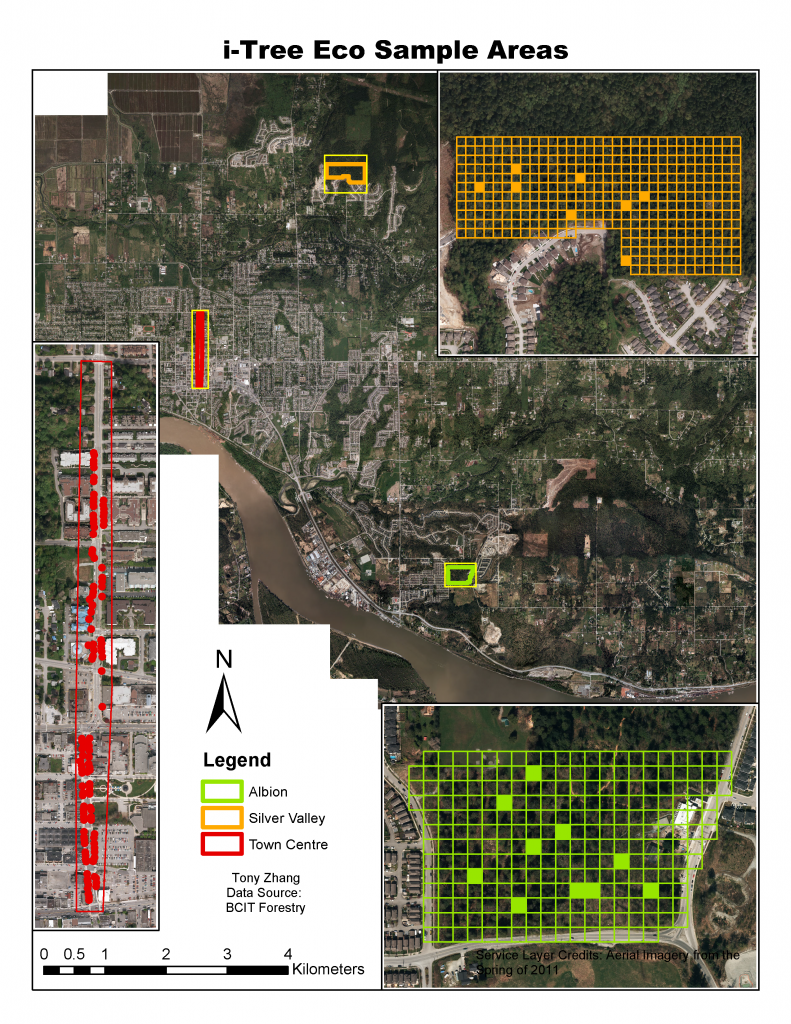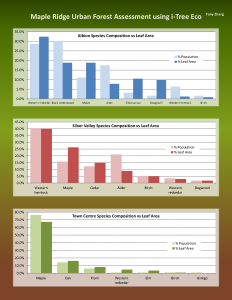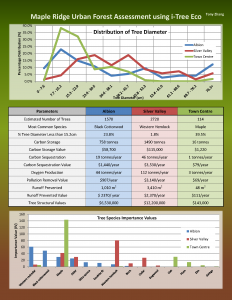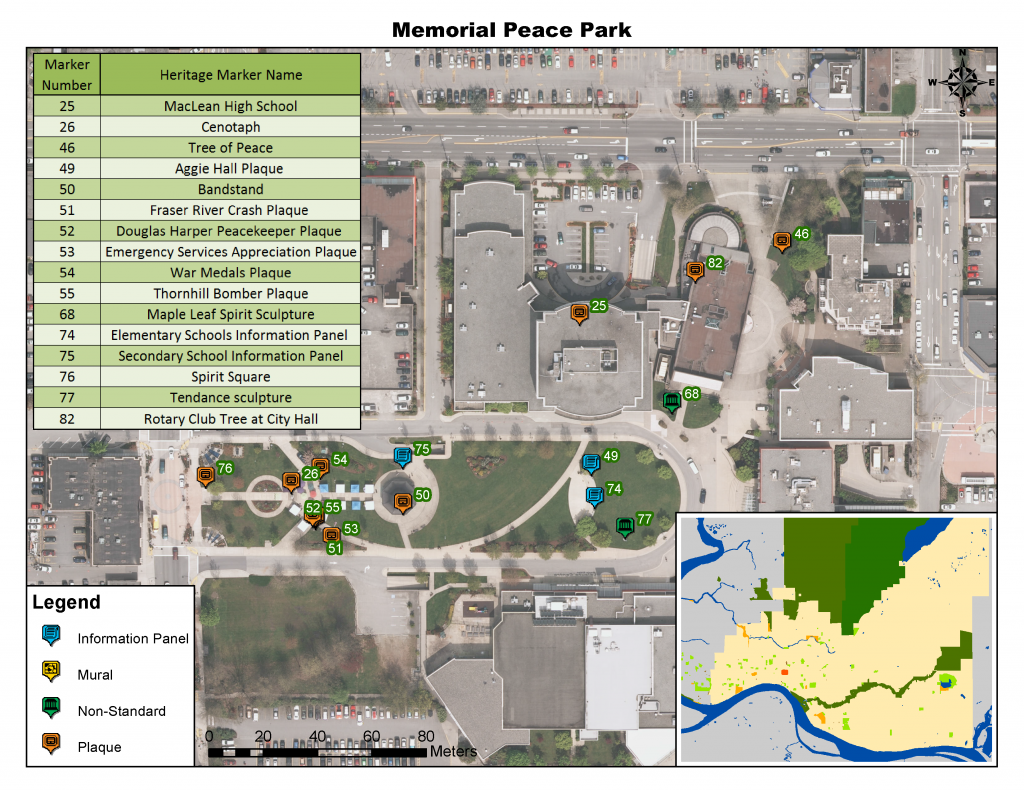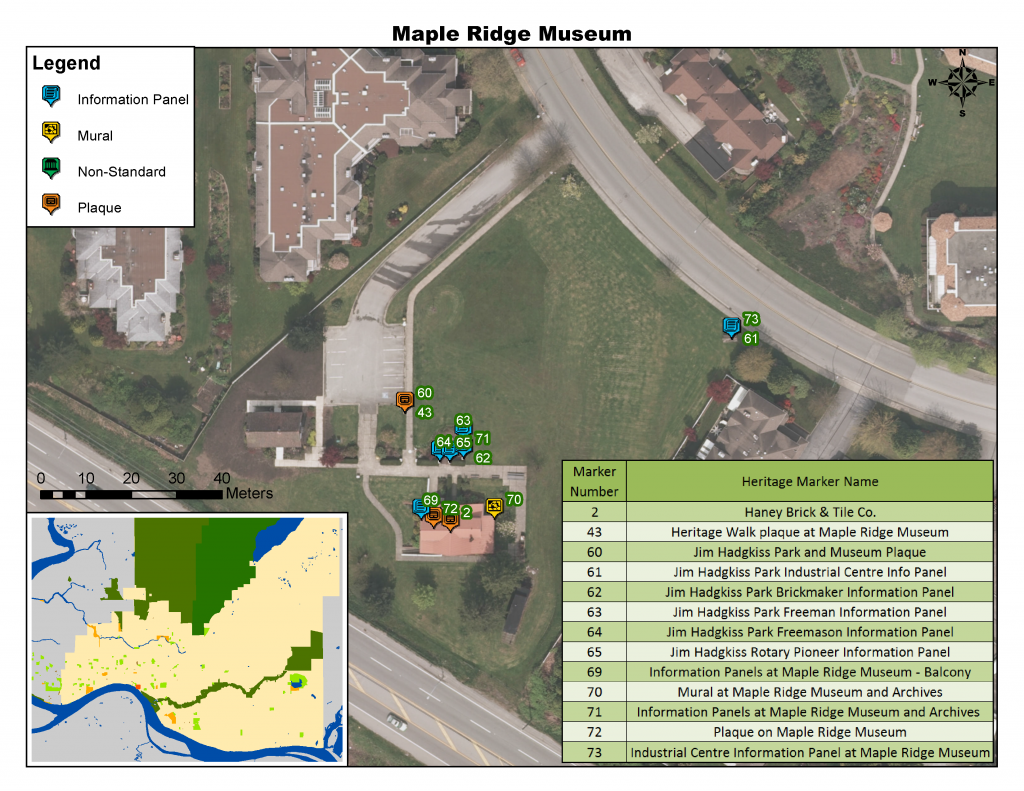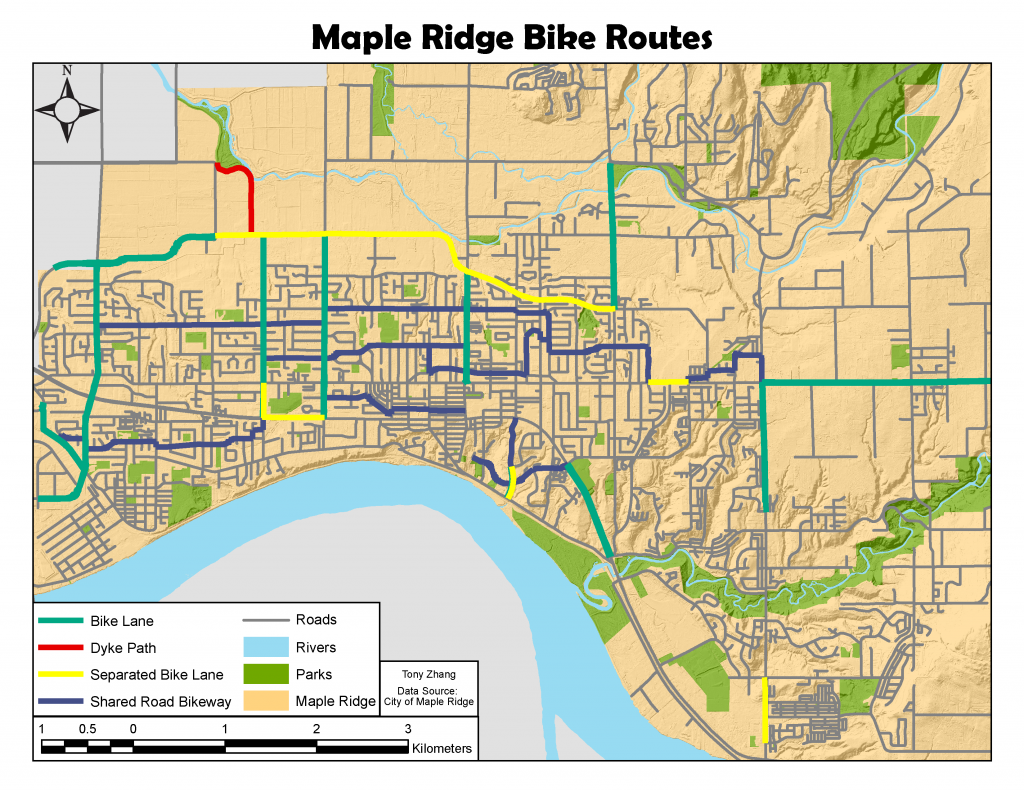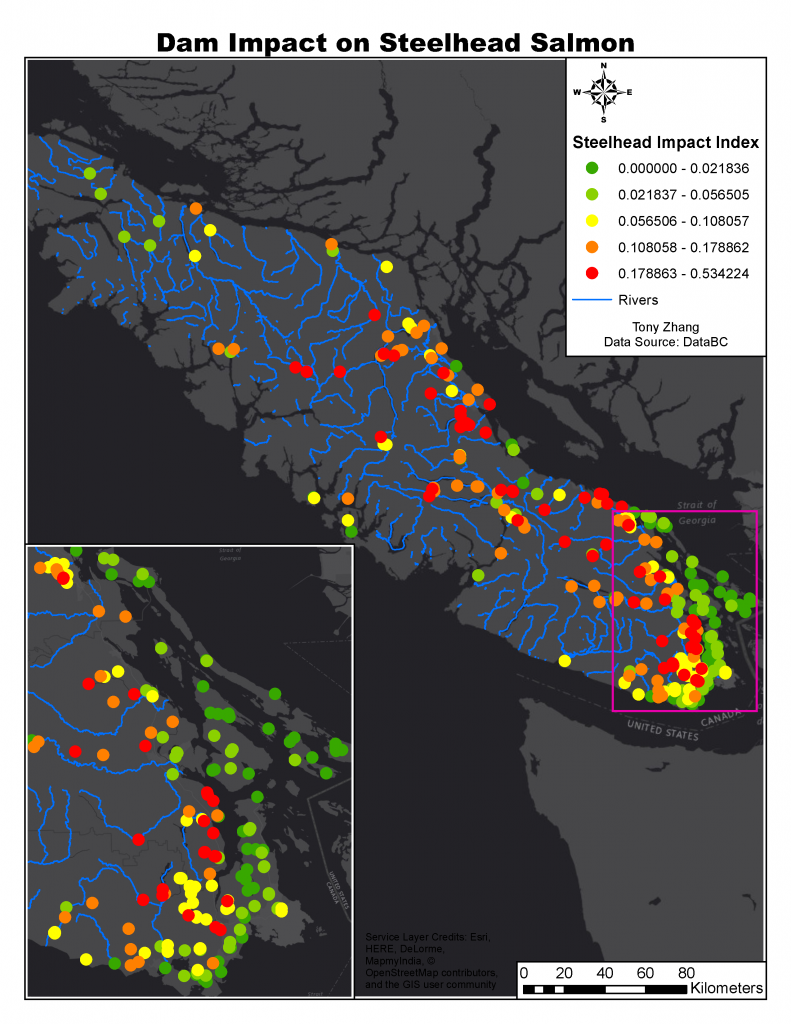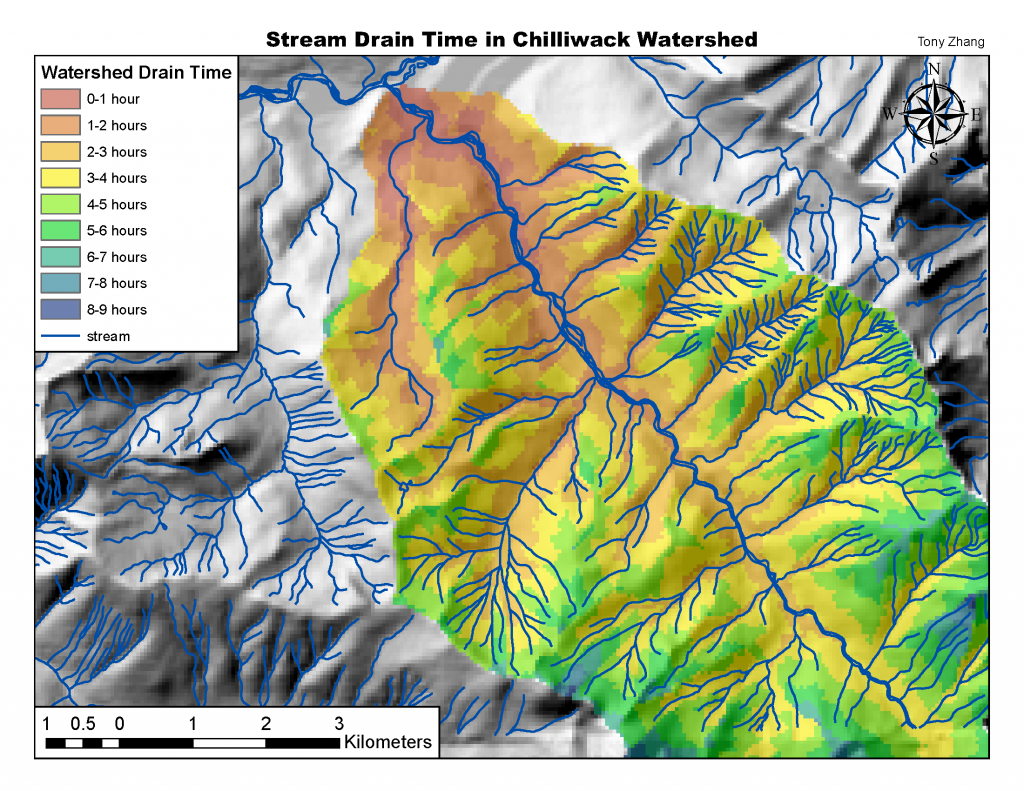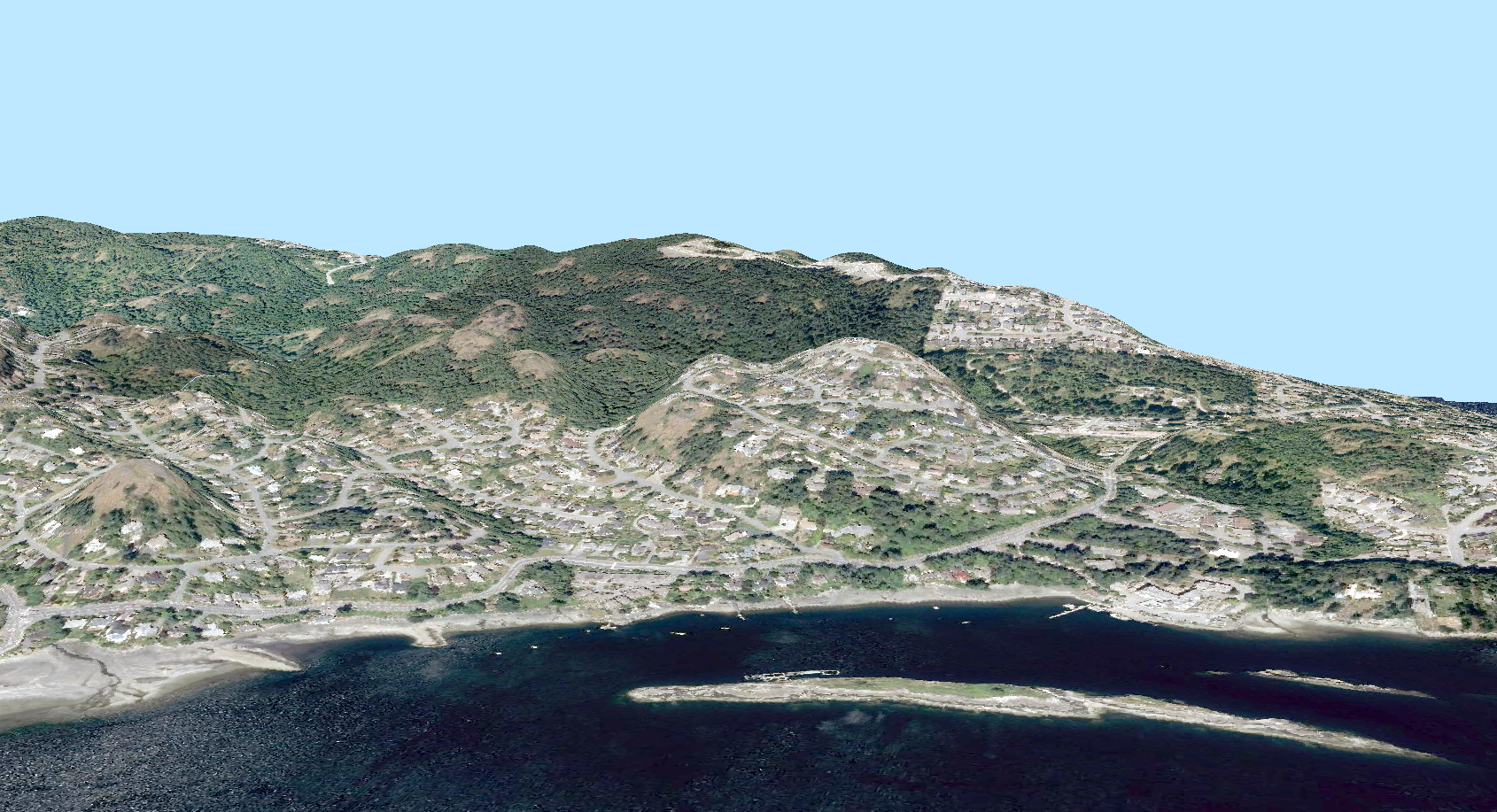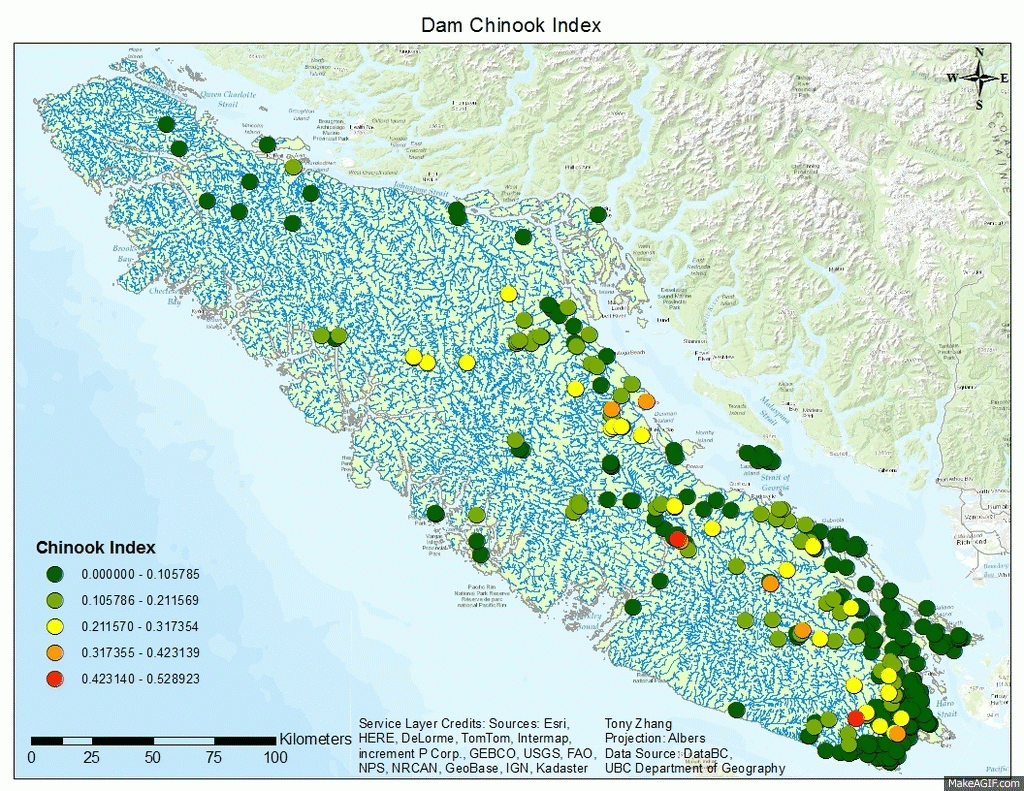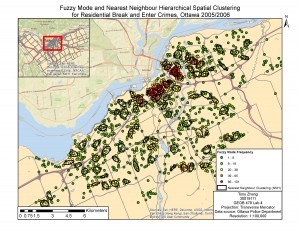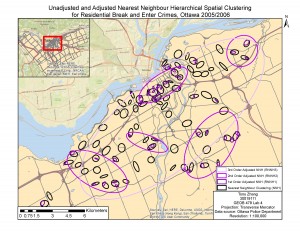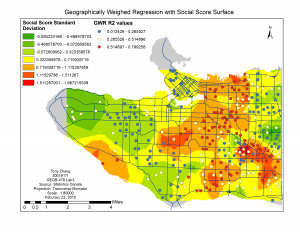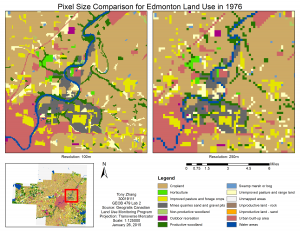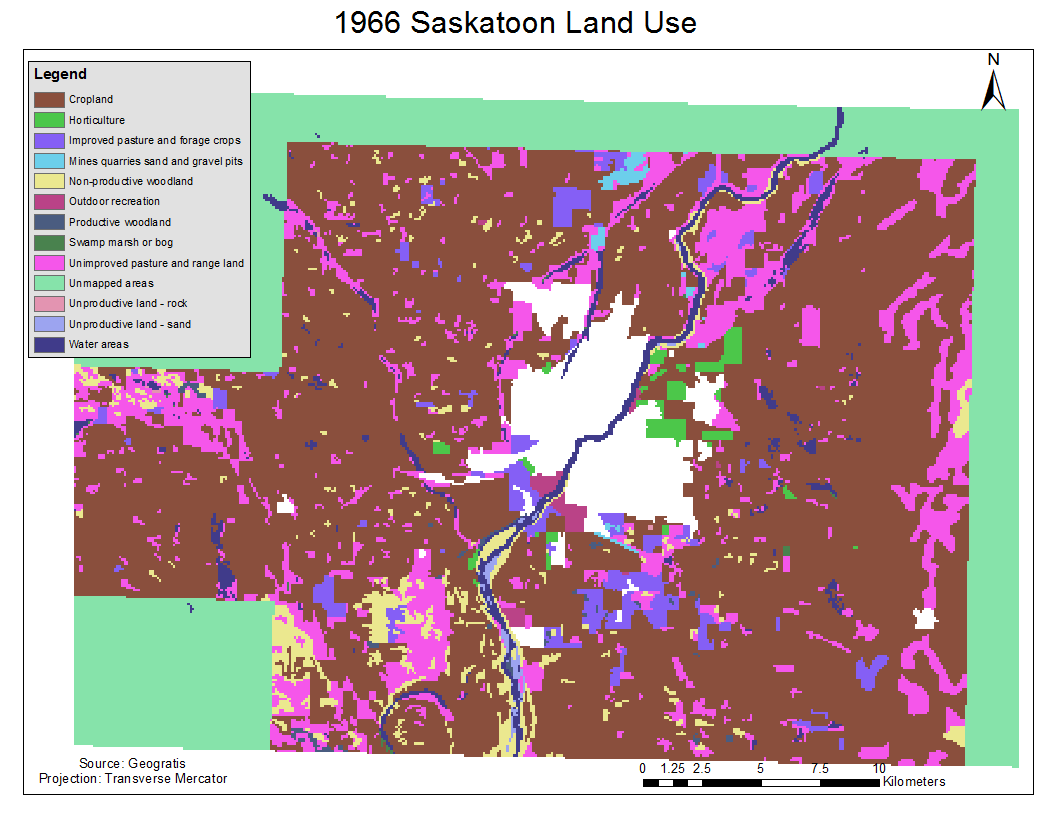Thanks to data collected by BCIT’s Forestry students we were able to use i-Tree Eco tool to produce some interesting statistics on the environmental and economic values of trees in the city. Here’s a map of 3 study areas and a sample of the results the tool was able to produce. Click on the charts to view bigger version.
Maple Ridge Heritage Sites
Maple Ridge Bike Routes
Dam Impacts on Steelhead Salmon of Vancouver Island
Watershed Flow Time
ArcScene
I started BCIT’s GIS ADP program and it’s super intense and busy so far. There haven’t been many opportunities to make cool maps since most of the labs are pretty technical. We’ve been testing out ArcScene with 3D data, so here’s a scene of Nanaimo with data I found on the city’s website. It would have been cool to make the buildings pop out too but unfortunately building height data isn’t complete for the whole city.
GEOB 479 Project
Week of March 30
This week we had our third and last journal article presentation, focused on crime analysis. The article I chose was called Comparing Police and Residents’ Perceptions of Crime in a Phoenix Neighbourhood Using Mental Maps in GIS, (link here). The objective of this article was to use mental maps created through resident and police interviews to see how perceptions differ between police and residents, and also to compare their perceptions to actual crime. The mental maps created through interview for both police and residents were digitized and aggregated into ArcGIS for analysis. The researchers found that police and residents had very different perceptions of crime, with residents emphasizing areas of safety while police emphasizing areas of danger. Also, perceptions of neither groups showed good correlation to actual crime. The researchers believed this is because residents tend to feel safer in their own neighbourhoods regardless of actual crime, while police are heavily influenced by historical events, and even if an area no longer have frequent crimes police will still feel danger in that area. Overall this article did a good job improving upon previous studies of a similar nature, but I felt that the surveying methods were too different between residents and police for comparison, and the presentation of maps could have been better.
One other article I liked was the on the relations between parks and housing values. The researchers found that parks can lower the housing price of surrounding areas. I thought this was surprising because I always thought of parks as a point of interest like schools or shopping centres which home buys often look for. But it turns out parks can also be hotspots for crime which in turn makes a neighbourhood less desirable.
Week of March 23
Week of March 16
This week we talked about GIS in relation to crime. This is similar to health geography in that GIS can be used to both map trends and to mitigate/prevent future problems. There are several major criminology theories. The first one is called Routine Activity Theory which is based on the activity patterns of both criminals and victims. For example criminals will more likely commit crimes car thefts at malls than at parks. Another theory is called Rational Choice Theory, which describes that criminals will pick time and place where they are likely to maximize profit and minimize being caught. A third is called Criminal Pattern Theory, which says that crimes will be related to the daily patterns of criminals. These three theories are all part of Environmental Criminology, which focuses on both the spatial distribution of offenders and offences. One way of minimizing crime is through Geographic Profiling, which is to locate and focus on areas of highest crime likelihood. Criminals are also divided into commuters (commit crimes far from home) and marauders (commit crimes around home), and different crimes will likely have different proportions of commuters and marauders. All of these theories and patterns, especially spatial patterns, are used in GIS to help with crime analysis.
We also finished Lab 4 this week, which uses the CrimeStat program for crime analysis. We looked mainly at spatial trends but explored temporal trends too for Ottawa crime data. CrimeStat is able to calculate different kinds of indices relating to distance such as nearest neighbour clustering and Moran’s I correlograms. Moran’s I and Nearest Neighbour analysis is similar, but differs in that Moran’s I looks at the predictability of crime among various regions (Dissemination Areas in our case) while Nearest Neighbour looks at spatial clustering between actual points. Despite small differences, both Moran’s I and Nearest Neighbour appears to show decreased correlation the farther it is from the chosen point/area.
Various methods of identifying crime hotspots were examined. One method we used was Fuzzy Mode, which produces frequency points by analysing crime from its surroundings. One advantage of Fuzzy mode is that it can easily identify hotspots without creating exact areas or points since it samples nearby points. Another method was Nearest Neighbour Hierarchical Spatial Clustering. This method is split between Standard and Risk-Adjusted Nearest Neighbour Hierarchical Spatial Clustering, both of which tries to create ellipses that represent clusters of crime. In theory both methods should be able to create multiple orders, with higher orders being larger ellipses that groups lower orders, but only the Risk-Adjusted version created higher order clusters in our lab. This might be because Risk-Adjusted Nearest Neighbour is normalized rate, while Standard Nearest Neighbour maps absolute crime volume. Another hotspot analysis method was Kernel Density Estimates, which is split between Single surface and Double surface. Single Surface Kernel Density maps absolute crime volume like Fuzzy and Standard Nearest Neighbour while Double Surface Kernel Density maps normalized crime rate like Risk-Adjusted Nearest Neighbour.
Lastly we examined the Knox Index in relation to car theft. This tool looks at both temporal and spatial relations by examining at whether the thefts are close or not close in space, and whether thefts are close or not close in time.
Week of March 9
This week we had presentations on journal articles related to health geography. The article I chose is called Mapping Risk of Plague in Qinghai-Tibetan Plateau, China (link). I chose to look at an article related to the Plague because it’s interesting how such a devastating disease from the past is nearly forgotten by most people, but it is still occurring in many places and can be deadly if people have no immediate access to antibiotics. The objective of the article was to map risk of Plague by examining the distribution of its host, the marmots.
The methods are not over-complicated as seen below:
1) Ecological Niche Modelling
– Use infected marmot data and environmental variables to create Plague probability map
– Use Maxent program to train 75% of presence data, and test accuracy with remaining 25%
2) Human Risk Assessment
– Calculate optimal probability cut-off point, pixels with values higher than cut-off point predicted to have Plague
– Overlay with human distribution data to determine at-risk areas
Map:
Overall I felt this was a pretty good article, with statistically significant results and through explanations. The authors also discussed a lot of limitations to the method. One thing they didn’t address that I felt was important was the difference between enzootic infections (longer periods of low infection rates) and epizootic infections (rare and short periods with very high infection rates).
There were many interesting articles being presented with various kinds of objectives. For example one article looking at relation between travelling time to health centres and heights in Rwanda showed that the closer homes are to health centres, the taller people are. This relates to the topic of inequality that we talked about in previous classes, and in this case people with better access are likely to be healthier (with height as indicator).
Week of March 2
This week we talked about the uses of GIS in health geography. There are four major areas where GIS is used, which reflect the major ideas of health geography that we talked about last week. The four areas of application are spatial epidemiology, environmental hazards, modelling health services, and identifying health inequalities. The first major application, spatial epidemiology, is using GIS to understand spatial variations in health geography. Statistical measures are useful in learning about trends and mapping variations, but everything still depends on having good, up-to-date data which is usually not the case. The second application is environmental hazards, which can both map hazards and to prevent/mitigate future problems. The third and fourth applications, modelling health services and identifying health inequalities, are interrelated. Because mapping access to health services can usually expose inequality between different groups of people.
We also focused on the topic of epidemiology, which is “the study of the distribution and determinants of health and disease-related states in populations, and the application of this study to control health problems (lecture notes).” There is also a difference between health and disease. Health is more general and describes overall well-being, while disease requires a definition of some sort of debilitation. There are different ways of quantifying disease such new cases versus total cases, and the best way will usually depend on what the objective is. Finally, there are a variety of methods of displaying data, including smoothing which can help reduce irregularities and better visualize patterns, and standardization which can help make different areas more comparable.
Week of Feb. 23
This week we discussed Health Geography. Geography is very important in determining many human factors like health. Spatial analysis can help look at health trends such as obesity, disease, mental wellbeing and many others. Initially the study of health in relation to geography was called Medical Geography, which was looking at health through a geographical point of view. This point of view was followed by Health Geography, which is broader and gives more importance on the social and environmental points of view instead of the medical-centric Medical Geography.
There are 5 core ideas within Health Geography. The first idea is spatial patterning of diseases and health, which is finding health trends in relation to space, such as the famous John Snow’s cholera map. The second idea is spatial patterning of service provision, which relates health providers to medical needs. This is useful for things like creating new hospitals/clinics. The third idea is humanist approaches to Medical Geography, which relates health to social perspectives. The fourth idea is structuralist/materialist/critical approaches to Medical Geography, which links health to social constructs and equality. This is an interesting topic because health care availability usually tends to be more beneficial to the rich. The last idea is cultural approaches to Medical Geography, which highlights the cultural or local differences that might not be noticed at a broader regional/national level.
Week of Feb. 9
We only had one day of class this week because of Family Day, and on Wednesday we brainstormed ideas about our final projects. In a previous course with Professor Marwan Hassan we touched on the topic of dams and dam removal. I thought of doing something related to looking at changes before and after dam removal and comparing the differences. But the main limitations to any project would be data availability.
Week of Feb. 2
This week we presented our landscape ecology article reviews to the class. The article I reviewed is called “a modelling approach to infer the effects of wind farms on landscape connectivity for bats”. (Article Link Here) The authors wanted to better understand the impact of wind farms on bat commuting routes. The method used for this research is summarized in the diagram shown below, which is divided into three main sections:
1) Creating a Species Distribution Map (SDM)
– Creating variables from existing environmental data (land cover, digital terrain model, and hydrographic maps)
– Input variables into model along with 70% of bat presence data
– Test model accuracy with remaining 30% of bat presence data
– Repeat procedure 50 times to create binary SDM
2) Determining connectivity
– Use 3 proxies of linear variables from previous research with SDM to produce resistance surface
– Select 50 random points in and connect them together by calculating least cost pathways
– Repeat procedure 10 times and summarize results in Potential Commuting Corridor map (PCC)
3) Wind farm interference
– Create map of all existing and future wind turbine locations and add 150m buffer to each
– Overlay wind turbine map with PCC
– If a PCC crosses a buffer, that turbine will be labeled as “affected”
In the end the researchers found areas with the most windfarm impact therefore they suggest those turbines be curtailed during bat migration seasons as well as putting limitations on future turbine construction.
Overall I would rate this article a 6 out of 10. Despite having successfully completing the goals they set out with and having good replicability in their results, 2 potential limitations made me rate the article lower:
1) The researchers chose this specific bat species because of its vulnerabilities to wind farms and migratory nature. They also noted how lots of turbine deaths were bats on their migration. But then the researchers decided to assume all the PCCs they produced were for commuting (daily) rather than migrating (annual) routes because of the lack of information of migration. Why ignore migration completely after putting so much emphasis on it?
2) I felt that the binary SDM was too simple for representing a complex factor like suitability. In nature there obviously isn’t a clear boundary where suddenly it becomes unsuitable for bats. Having a gradient or several classes would have been a better way of representing suitability.
I also found it interesting that several other studies presented used the same methodology and spatial analysis program (MaxEnt), and that this research was just following some of the “standard” processes set by previous research.
Week of Jan. 26
We had a review of many statistical ideas to help with lab 3. The major topic was on regression since it can help model patterns. Ordinary Least Squares (OLS) is simple and one of the most commonly used regression models that can show overall patterns. However OLS has a “global” nature, which means it assumes everything is the same over space. This is a limitation when working with spatial data with heterogeneity. So Geographically Weighed Regression (GWR) has become one of the more popular methods recently due to its ability to create a “local” model that varies over space.
The lab for this week was also focused on GWR and children’s language skills in relation to several variables. Firstly we used the Explanatory Regression Analysis tool to determine which set of variables provides the best relations. We then used OLS tool to produce a general global result, and compared that to results produced using the GWR tool. Finally we produced grouping clusters using the Grouping Analysis tool to see if we can relate the results from OLS and GWR to other variables used to create the groups. I found that only two of the three variables are statistically significant from OLS, and the map of OLS residuals showed no significant spatial patterns. As for the GWR results, the surface map of social score showed good correlation with GWR R2 values, so it would seem that social scores and language scores have the strongest relation.
Week of Jan. 19
Spatial patterns vary greatly in space and it is difficult to work with only one scale because it won’t capture everything we want. Spatial Autocorrelation is a common measurement method used to analyse patterns, and it is the distribution of objects or events on the landscape, and how clustered or dispersed they are. However there is likely more than one pattern that exists when we work with different scales. As a result the patterns are classified as either first-order or second-order. First-order processes show patterns determined by environment, for example rabbits clustering around a food source. Second-order processes show patterns caused by the objects or events themselves, for example rabbits clustering around each other for protection. Stationarity is another process that was discussed. It is a measure of how well patterns stay the same over space. Changes in space measured are relative locations as opposed to absolute locations because this allows us to see the patterns among the points. First-order stationary is when the patterns remain the same everywhere in space. Second-order stationary is when the process is random but will depend on time or space. Direction plays an important part here, since processes that favour certain directions (anisotropic pattern) can create distinct patterns such as having a slope or mountain ridge. On the other hand patterns can also favour any direction equally (isotropic).
We also discussed the different processes that can affect the landscape. Abiotic processes are physical factors like climate, topography, and soil composition. Biotic processes are caused by living organisms and their interactions, such as the power of keystone species in controlling other species and the environment. Two other effects that are becoming more important are anthropogenic processes and natural disturbances like earthquakes and fires. These processes can contribute to local uniqueness, phase difference, and also dispersal, which all cause spatial patterns. There are also many metrics that can help measure different patterns, such as diversity, connectivity, and dominance. However it is important to know what processes are at work, and also knowing a good scale for the processes.
Week of Jan. 12
Scale is the main topic described in this week. Because the real world is so complex with so many interactions between factors that we can never find all of them. As a result we often have to decide on a scale that gives a fair representation of what we want to achieve. For example regarding the “marauders” that disturb areas outside their own local scale, should we choose a large scale that includes the marauders’ homes, or should we focus on a smaller scale that gives better representation of the effects within the area of significance? One way of solving this dilemma is to conduct a multiscale analysis, which can give a more complete view of a topic by focusing on factors that are specific to each scale. The problems with scale can be found in many known problems such as the Simpson’s paradox where aggregating data groups change overall results, Modifiable Areal Unit Problem where the same data can produce different results when area is changed, and Ecological fallacy where creating a larger scale can often simplify and misrepresent the details within an area.
The lab for this week used the same processes as lab 1 but uses the city of Edmonton and focuses more on the results produced by Fragstats. We included several additional class and landscape metrics that we deemed to be important. We also created a transition matrix that compared the changes in land use from 1966 to 1976. The transition matrix was much more useful compared to just the two years’ land use areas side by side, because a transition matrix can show us exactly how each portion of land use changed to what. For example with only a simple table we see that non-productive woodland (NPW) areas changed from 19000ha to 7300ha in the ten years, and a logical assumption would be that the 7300ha are the remainder of the 19000ha from 1966. But if we look at the transition matrix, we see that only about 8% of the 19000ha of NPW remained in 1977. It also showed what percentage of other land uses were created from the 1966 NPW, and how the initial NPW changed into other land uses. Effects of scale was also discussed in this lab, where a larger pixel size of 250m looked very different from a 100m pixel map, and many features like river and roads became indistinguishable.
Week of Jan. 5
This week we talked about three important but different areas where GIS is important, and they are related through five common themes: patterns, processes, places, people, and perspectives. The first area is landscape ecology, a sub-branch of ecology. Ecology in general is the effects of biotic and abiotic factors on organisms, and landscape ecology focuses more on specifically how the landscape as a factor affects those organisms. Another area is health geography. Health geography is very wide branching, and includes topics like disease ecology, health care delivery, and the relation between environmental and health studies. The third area we discussed is crime analysis. By analysing existing data we can find patterns that help with crime prevention and mitigation. The story about how lead in gasoline was related to crime was interesting, because it showed the impossibility of knowing the complete truth, but analysing data and using statistics can help explain or predict patterns with close enough results despite only having theories for guidance.
We also started working on our first lab which was to help us learn the basics of Fragstats program. Using ArcGIS, we created land use raster files for Saskatoon in 1966 and 1976, and exported it as TIFF files that Fragstats can use. In Fragstats we calculated several class-scale (for each land use area) metrics and a few landscape-scale (whole map) metrics. Determining “edge” depth for each patch was also important for many metrics because it creates different habitats compared to inner areas which cause ecological implications. The resulting metrics can then be exported into other programs like Excel for making comparisons or creating tables and graphs. Below is a sample map for the raster stage of the data in ArcGIS.
